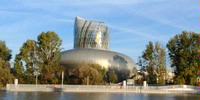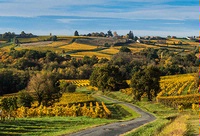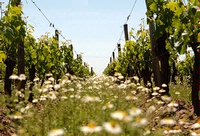It’s been a few years since I visited the city of Bordeaux. But I’m happy to report that he Grand Lady that has served as the center of the Bordeaux wine trade since Eleanor of Acquitane married England’s King Henry Plantagenet has cleaned up her act. The port that sat between the Garonne River and the city center has been moved further along the river, which makes the city feel very open and welcoming.
Beautiful garden spaces with lush plantings of sculptural grasses and colorful flowers lining the busy walkway along the Quai de Chartrons on the left bank of the Garonne River create softness and a feeling of calm. A large rectangular area beside the walkway holds a shallow pond that I expected to put on a water show. But no, the Miroir d’Eau, water mirror, is an art installation that regularly drains the water to a very shallow level, presenting a perfect reflection of the grand buildings on the other side of the street.
Those buildings are no longer black with the accumulation of ages of air pollution. They have been scrubbed and cleaned, baring the pale golden limestone of the facades. An elaborate tram system wends its way through the throngs of cars bikers and pedestrians. In the old part of the city, cars are not allowed, but you do have you look out for the trams and bikers.
A new bridge across the Garonne named Pont Jacques-Chaban-Delmas was completed in 2013. It is a lift bridge with a center portion that can be raised about 175 to allow large ships to pass through. Now, instead of vessels carrying cargoes of wine to wine lovers around the world, huge cruise ships bring people to visit and sample the region’s wine and cuisine. Smaller boats take groups on the river to visit wineries.
The credit for this remarkable transformation goes to the city’s mayor, Alain Juppé, former Prime Minister of France. It was recognized by UNESCO as a World Heritage site for its, ”…vast Enlightenment-era urban core.”
In 2016, an unusual structure was opened on the river bank. The Cité du Vin is housed in a ten-story structure designed by Anouk Legendre and Nicolas Desmazières. The design is meant to depict the swirl of wine in a  glass. It is an interactive museum celebrating wine and its culture from around the world. It offers permanent and temporary exhibits, educational workshops, wine tastings, restaurants and guided wine tours.
glass. It is an interactive museum celebrating wine and its culture from around the world. It offers permanent and temporary exhibits, educational workshops, wine tastings, restaurants and guided wine tours.
As the city has been revitalized, the Bordeaux wine industry is working to make the business of grape growing and winemaking more sustainable. The Bordeaux Wine Council, CIVB, is an industry-funded organization that executes marketing efforts, funds research and provides educational materials and programs for the industry. One major area of concern is encouraging and helping wine producers to utilize sustainable practices, reduce their environmental footprint and collaborate to adopt an Environmental Management System, EMS, plan. An EMS is a set of processes and practices that enable an organization to reduce its environmental impacts and increase its operating efficiency.
 According to a report from the CIVB, in 2016 there were 680 businesses committed to developing and enacting an EMS. Also, 467 winegrowing estates were certified organic and being converted, and 44 were Demeter certified biodynamic or in the process of being converted.
According to a report from the CIVB, in 2016 there were 680 businesses committed to developing and enacting an EMS. Also, 467 winegrowing estates were certified organic and being converted, and 44 were Demeter certified biodynamic or in the process of being converted.
The report also contained examples of practices that wine estates have adopted to be more sustainable, such as, making sure everyone in the organization is educated about and participates in the efforts:
–Adding natural light when possible to save energy. Using ultra smooth tanks to cut down on water use;
–Employing double-walled tanks and concrete tanks to reduce energy consumption;
–Installing beehives to monitor environmental quality since bees are pollinators in direct contact with a variety of plants;
–Planting hedges that provide a barrier between the winery and its neighbors, providing biodiversity and mitigate the effect of wind or temperature differences;
–Having the right equipment and using it properly to save resources;
–Weather stations to be able to react efficiently to changing conditions;
–Solar panels to contribute power.
Considering some particularly innovating and exemplary producers:
Château de Lugagnac has a natural spring that flows beneath its winery. In order to cool the winery naturally, they diverted the spring’s path. They also collect rainwater and have a water purification plant that can treat the water used to clean barrels and bottling lines to water young plantings.
Château de Reignac and Château Laurent Rousseau both use patented technology that relies upon the bamboo plant’s natural ability to host bacteria in their roots that are able to decompose the pollutants in the winery waste water. It’s a win-win situation because those bacteria serve as a fertilizer for the bamboo
Château Dauzac added a glass stave to wooden tanks that allows them to how well the pumice and juice are mixed. They save power by being able to stop the pumps as soon as they’ve reached the desired mix.
Château Poupille’s owner heats his home and work areas with the use of a vine shoot burner to recover the combustion energy.
It is exciting to see the thought, effort and innovation that is being applied to work toward sustainability, to be stewards of the earth. Certainly,  self-interest is a factor, but it is also a great motivator.
self-interest is a factor, but it is also a great motivator.
Connect with her on Twitter at @RebeccaOnWine
